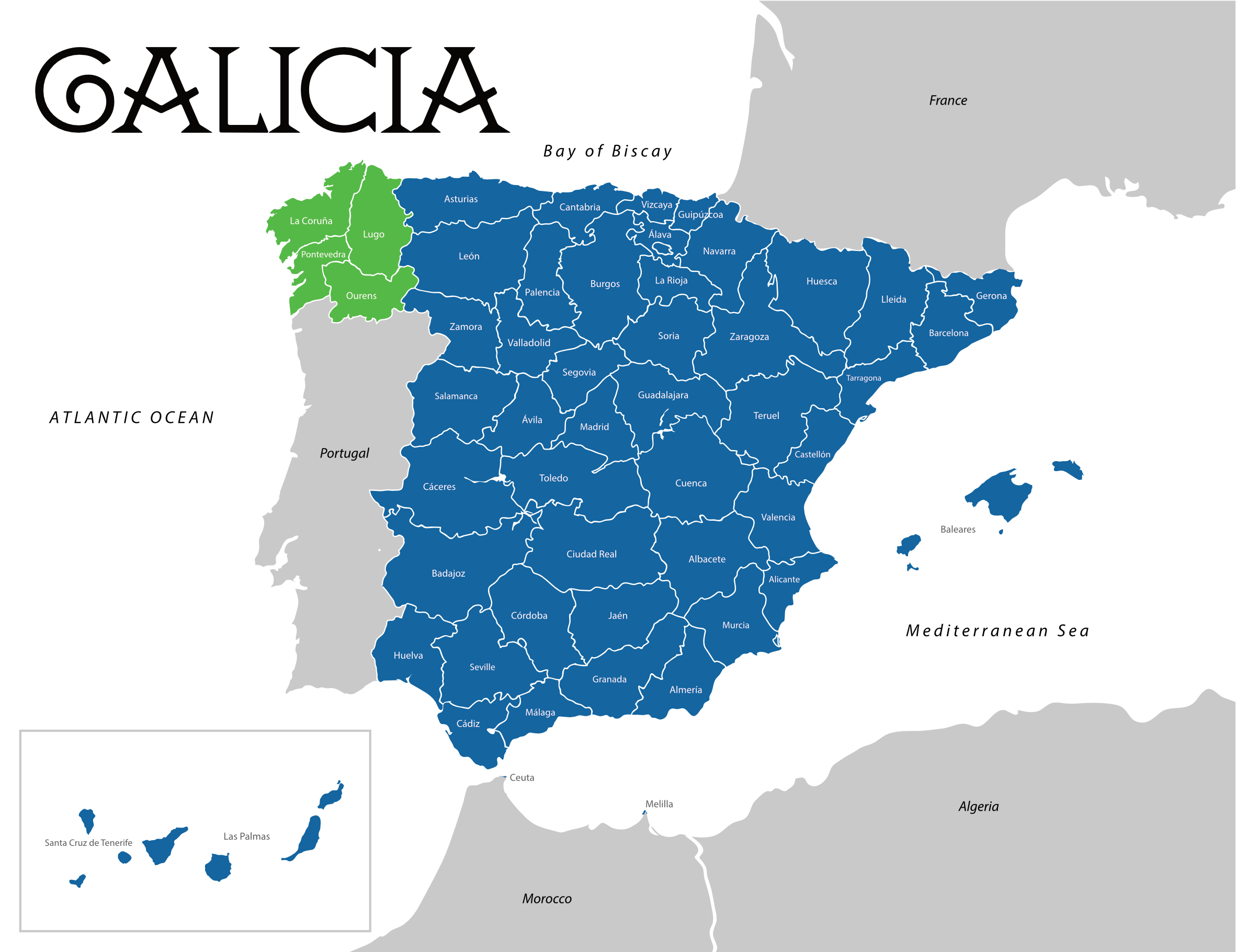If you are looking for a unique and beautiful destination in Spain, you might want to consider Galicia. Galicia is an autonomous community and historic region in the northwest of the Iberian Peninsula, bordering Portugal to the south and the Atlantic Ocean to the west. It has its own language, culture, and traditions that make it stand out from the rest of Spain.
But where exactly is Galicia? How far is it from other major cities in Spain? And how can you get there? For many people, Galicia remains a bit of a mystery and in this blog post, we will answer these questions and more!
Where is Galicia? Distance from other cities
Galicia has four provinces: A Coruña, Lugo, Ourense, and Pontevedra. The capital of Galicia is Santiago de Compostela, which is also the final destination of the famous Camino de Santiago pilgrimage route.
Here are some approximate distances by road from Santiago de Compostela to other popular cities in Spain:
- Madrid: 600 km (373 miles)
- Barcelona: 1,100 km (684 miles)
- Malaga: 1,000 km (621 miles)
Of course, these distances may vary depending on your exact starting point and route. You can use online tools like Google Maps or ViaMichelin to plan your trip and calculate your travel time.
Nearest airports
The easiest way to get to Galicia by air is to fly to one of its three international airports:
- A Coruña Airport (LCG): located about 8 km (5 miles) from the city center of A Coruña. It offers flights to Madrid, Barcelona, London, Lisbon, Amsterdam, Paris, and other destinations.
- Santiago de Compostela Airport (SCQ): located about 16 km (10 miles) from the city center of Santiago de Compostela. It offers flights to Madrid, Barcelona, London, Dublin, Frankfurt, Rome,
and other destinations. - Vigo Airport (VGO): located about 9 km (6 miles) from the city center of Vigo. It offers flights to Madrid, Barcelona, London, Paris, Bilbao, and other destinations.
You can also fly to Porto Airport (OPO) in Portugal and then take a bus or a train to Galicia as Porto is only about 150 km (93 miles) away from Vigo.
Ferries to Santander and Bilboa
Ferries are a great option if you want to bring your own car or camper van. They also make travelling with pets an easier prospect.
There are several ferry operators that offer services between the UK and Spain. The most direct and frequent ones are Brittany Ferries and AT Ferries (Acciono Trasmediterranea).
Brittany Ferries operates three routes from Portsmouth and Plymouth to Santander and Bilbao. The sailings take between 20 and 36 hours depending on route and departure time. You can choose from different types of tickets depending on your budget and flexibility. You can also book accommodation in Galicia through their website.
AT Ferries operates one route from Portsmouth to Bilbao on their superferry Fortuny. The sailing takes about 32 hours and has a capacity of 1000 passengers and 330 vehicles. The ferry has comfortable cabins, lounges, restaurants, bars and entertainment options.
You can compare prices, timetables and availability of different ferries online using websites such as Direct Ferries or Ferry Cheap.
Why visit Galicia?
One of the most attractive features of Galicia is its coastline, which stretches for over 1,500 kilometers and boasts some of the most beautiful beaches in Europe. The coast of Lugo, in particular, is a hidden gem that deserves your attention. Here are some reasons why you should visit this amazing area and explore the rest of Galicia as well.
The Beaches
The coast of Lugo has more than 100 beaches to choose from, ranging from sandy coves to rocky cliffs. Some of the most popular ones are As Catedrais (The Cathedrals), which features impressive natural arches and caves; A Rapadoira, which has fine white sand and clear water; and Os Castros, which offers spectacular views of the Atlantic Ocean. You can enjoy swimming, surfing, kayaking or simply sunbathing on these pristine shores.
The Nature
The coast of Lugo is also home to some of the most diverse and protected natural areas in Galicia. You can visit the Souto da Retorta Natural Monument, where you can see giant eucalyptus trees that are over 100 years old; the Fragas do Eume Natural Park, where you can hike through lush forests and waterfalls; or the Illa Pancha Lighthouse, where you can spot dolphins and seabirds. You can also take a boat trip to the Islas Cíes (Cies Islands), which are part of the Atlantic Islands National Park and have been called “the Galician Caribbean” for their turquoise waters and white sand.
The Culture
The coast of Lugo is not only a place to enjoy nature but also to learn about the rich culture and history of Galicia. You can visit the town of Ribadeo, which has a charming old quarter with medieval buildings and churches; the town of Foz, which has a Romanesque basilica and a Celtic fort; or the town of Viveiro, which has a Gothic cathedral and a lively market. You can also discover the Celtic roots of Galicia by visiting some of its ancient castros (hill forts), such as Castro de Fazouro or Castro de Coaña.
The Gastronomy
No visit to Galicia would be complete without tasting its delicious cuisine, which is based on fresh seafood, meat and vegetables. The coast of Lugo offers some of the best seafood in Spain, such as percebes (goose barnacles), nécoras (velvet crabs), pulpo á feira (octopus with paprika) or empanada gallega (savory pie). You can also try some typical dishes from inland Galicia such as lacón con grelos (pork shoulder with turnip greens), caldo gallego (Galician soup) or tarta de Santiago (almond cake). And don’t forget to wash it all down with some albariño wine or queimada (flaming liquor).
So… if you have been wondering ‘where is Galicia’ now you know AND you know why it is an exciting area to discover with something for everyone!

